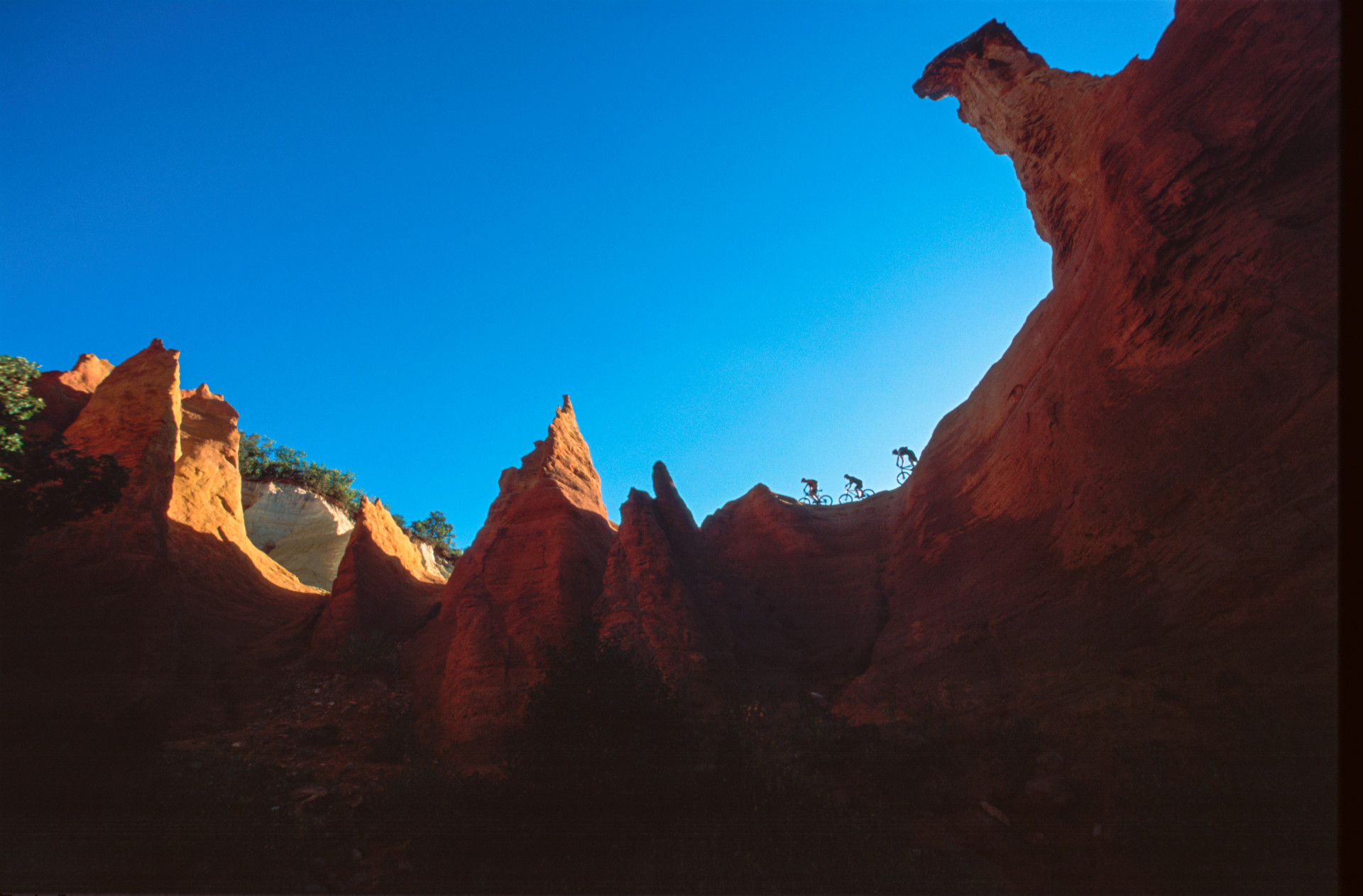Geoff Waugh
Cycle sport snapper and Sports Photographer of the Year award winner Geoff Waugh shares his story behind the image
Hi Geoff, tell us about yourself
I'm Geoff Waugh, a long time outdoor photographer that fell into the game after a spell as a journalist on a weekly angling newspaper. The paper had a drawer full of cameras and I was assigned one each time I was sent out on a job. Having an art school background meant that pretty soon making images became more interesting than the writing and eventually I quit to go full time as a self employed photographer. Before then I had never touched an SLR film camera so I dived deep into every aspect of it and taught myself. No You Tube back then so it was books, manuals and trial and error, burning up film and paper and hang the expense!I had a general interest in sport and swayed towards photographing action at the time. Like the angling it kept me outside in the air and in nature - a constant throughout my career. When the national bike race tour came to London I looked at the course and saw it went right past my old place of employment and I knew there was a rooftop vantage point. I shot some frames of the fast and colourful bunch of racers reflected in a mirrored office block window and sold them to a magazine. I was on my way.
I photographed various sports for national newspapers, loving the buzz of the deadline and the darkroom, but before long I narrowed my attentions to cyclesport, at that time, off the radar for the average person in the street. But that also meant there was only a handful of photographers recording the action. I quickly edged my way in.
Without sounding too cliched, my inspiration comes from many areas. I love pawing over photobooks from the masters like Ernst Haas, Fred Herzog and Joel Meyervitz rather than the work other action photographers. Being an editorial photographer in magazines meant the majority of the images I shot were on slide film so I am interested in the colours and the use of light by these giants of photography. Of course, I would be foolish to ignore the work of the Getty guys and was blown away by the images coming out of the recent Olympics in Japan. I always am.
What's your most memorable photo?
One? Just one? That is like asking me to name my favourite David Bowie album! It changes from day to day.
What I can say is that a handful of my images have become known to a lot of people that follow the sport I photograph and that is good enough for me. One image that seems to have got a life of its own is a picture I took of the American snowboard star turned mountain biker, Shaun Palmer at the World Championships in Sweden. I decided to shoot around the finish area for the race finals and Palmer was on a winning run until he crashed metres from the line. There was only one other photographer there and he was too close to the action to get a good frame. I was way back shooting with a 300mm lens and got a sequence of Palmer on the ground and eventually leaning back against the barriers checking his tattoos for damage. One of the frames clearly shows his disappointment and frustration, and this one has been ordered as a print and pinned to the lamp post near his crash spot on the tenth anniversary of the event!
And then there would be the one that won me the Sports Photographer of the Year award that I never picked up because I remember thinking I didn’t stand a chance. This even though I knew the guy that printed the image for the competition and dropped heavy hints that I was too dense to cotton on to!
I am proud of an image I shot that made the front cover of the BIKE magazine photo annual edition which is about as high a coup as a mountain bike photographer can get. Again. an image I shot at the end of a session photographing something else. The rider turned up, I saw he had amazing skills and the light and location all merged to make a great image. But as I said, I cannot pin it down just one image.



What's in the bag?
I never carry digital and film stuff together. What goes into the bag is totally dependent on the kind of commission or personal work I am undertaking which implies that digital is for work and film is for personal, and that is about right.
For the majority of work I can get everything I need with two bodies; a Nikon D4 and a D750 with 24-70mm 2.8 and 70-200mm 2.8 lenses. This is what I would call my standard rig. There is a 14-24mm 2.8 lens in there in case I need to go ultra wide but that is rare. I’m not a massive fan of distortion which occurs way more in action than, say, landscape photography where the wide glass would be more useful. I carry two speedlights in case I need to light up a scene - again, this doesn’t happen very often with the high ISO, low light performance of modern DSLRs - but they are good to use for static product shots, for example photographing a racing bike which deserves to look shiny and bling. I use Pocket Wizard III radio slaves to operate the flashes. A 1.4x teleconvertor is small enough to tuck away and offers that extra stretch if the situation demands it. There will always be spare camera batteries, spare AA batteries for the flash and radio slaves and a chamois cloth for when the weather takes a turn.
If a job is in a nice exotic or interesting location I will put my Sony RX100 MrkIII pocket cam in to wander around and shoot travel/street style photographs as a personal record, but occasionally to submit into an agency.
Coming from a film background I have found it hard to let go completely despite the quality of digital and that the entire business is now in 1s and 0s. So it’s no surprise that I have a few film bodies! The most used is my Hasselblad 501cm. I had never used one in the ‘film era’ so when I saw the results I was totally blown away and understood why so many top photographers stand by them. I have used this camera to shoot cycle races, but purely to give a different look to the end product. To say it is slow is an understatement. If I get through three rolls of 120 film in a one hour race I have done well. And if I get half a dozen keepers then I have done great! This is a personal challenge that tests my focus skills and even my eyesight! I often put a Fuji Instax Square instant camera in with the ‘Blad and shoot a frame to scan later or to simply keep in an album as a reminder of a location. I am gratified at the point of capture and then have the anticipation of waiting for the quality images to come back from the processing lab. I have photographed major bike races on Lomo toy cameras, 360 degree rotating film cameras and plastic panoramic cameras. It all keeps things fresh for me and often the subjects don’t take me too seriously at all without a huge DSLR pointing in their face so I get some nice at ease- looking results. Generally, I am travelling light with these cameras and they go into a crossbody style bag with a few rolls of film and a light meter in the pockets.

What does your next photography adventure look like?
My next photography project could involve a full bore assault on the cyclocross racing scene. I have photographed this many times but not for quite a long time so it will be nice to reacquaint myself with the nuances of the sport. It has already started here in the UK but the early races are generally run at the tale end of summer and are bright dry affairs which, to me, doesn’t contain the true essence of the discipline. I like it when it is cold, wet and muddy. Snowy if possible. The conditions always make for arresting images. It is a challenge for the riders and for me. The subject matter extends too since the pit crews are twice as busy cleaning and handing up bikes to the racers. Each race lasts an hour or less and the circuits are small so there is a myriad of photoops. There is also a film project in the pipeline. This will be far removed from what I shoot for business. A gentle drive along some coastline, picking choice locations.



How has photography evolved since you’ve started shooting?
The change has been HUGE! In camera terms I have gone from manual exposure and manual focussing to autofocus with some auto exposure modes, to the modern cams that can pick up a subject’s eye and bring it into focus in a split second; it is actually difficult to get a picture out of focus! That has levelled a playing field which means the successful photographer must be even more creative to separate themselves from the pack. Then the camera can transmit that image via WiFi. Phew! For news and sports snappers this transformation has been invaluable; the days of the motorcycle courier are well gone! Of course it means more pressure to get their image uploaded faster than their opposition which arguably can effect overall quality.
The modern DSLR and mirrorless are so good in low light situations that indoor sports are so much easier to work. Even the mixed lighting that indoor stadiums are prone to can be controlled or changed in post. Film allowed few of those luxuries. In my field being able to continue working in dark woods without resorting to flash has been a boon. The remote flashgun trend has fallen by the wayside in favour of natural light.
In working terms, the internet way of working has been way more of a challenge than working for any magazine. For pre-internet photographers navigating those waters is strange! Images only appear for short moments in time. Scoring a front cover - the absolute goal of any print photographer - is a thing of the past. That’s a shame. Conversely, of course, the positives of the Internet are free (to a point) marketing, as much free information and tuition as you could possibly want. The leaning curve is way quicker.
Another brilliant bonus for a disorganised guy like me is that data-basing images is sooo much easier. Numbering, Keywording, captions, locations etc. are all done as the images come off the camera to the hard drive. Imagine scanning a file drawer-load of images and then tweaking each one in post before the ultimate tedium of adding all the necessary details. Been there done that, never again!
Where will we find you when you're not taking photos?
On Instagram, on Facebook. Isn’t that where everyone is? When I get myself off the Mac I will be riding my MTB in the woods, decompressing and emptying my brain ready to, hopefully, fill it with fresh ideas. Then there is my ‘Dirty Jerseys’ projects which will be coffee table books for the retro and mountain bike history oriented reader. The first of the trilogy is near design completion now and I am currently planning shoots for the last in the series.
What advice have you got for the younger you, just starting out on your photography adventures?
Don’t forget sunscreen and food and water. Slow down and take a longer look. Don’t be so blasé with your images - in time they become priceless memories. Climbing a big hill will become harder. Don’t argue with so many race marshals! Always check yer backgrounds.
For newbies, I could say always keep your copyright, but that is harder and harder now and the actual Rights may have changed by the time they become working photographers. So I would say keep an eye on trends. Time was when having a good website was essential but I wonder about that in the Instagram age. Work on a look that people recognise as yours without compromising your vision for the sake of Followers. If you have a passion about a particular subject then you will get far superior results from photographing something that you feel strongly about and have an emotional connection.
Gallery





Thanks to Geoff for his generous time and input into creating this article. Geoff's images are reproduced with permission.
Geoff Waugh
Web: https://www.waughphotos.com/
Insta: www.instagram.com/geoff_waugh
Shop: www.dirtyjerseys.co.uk

